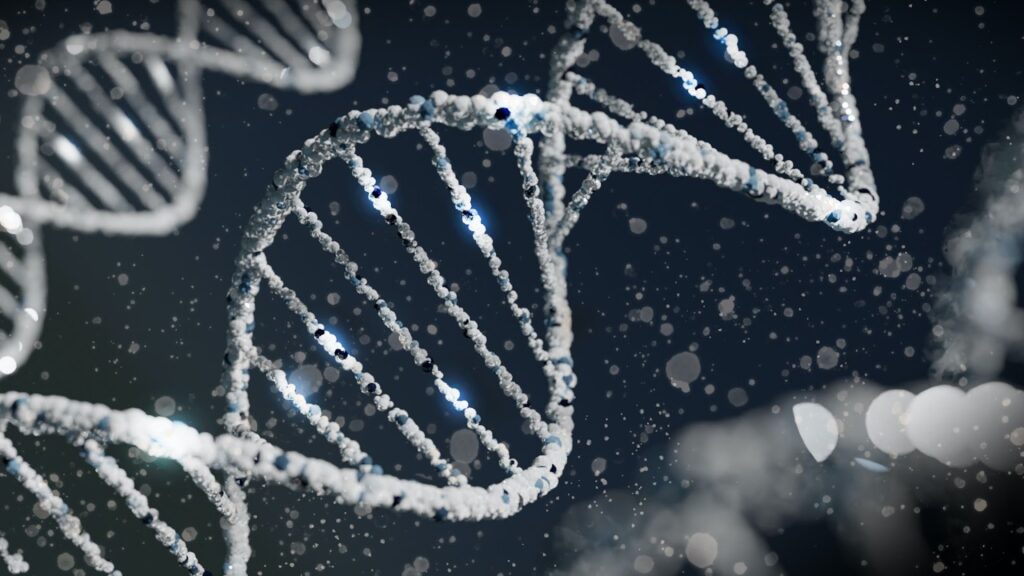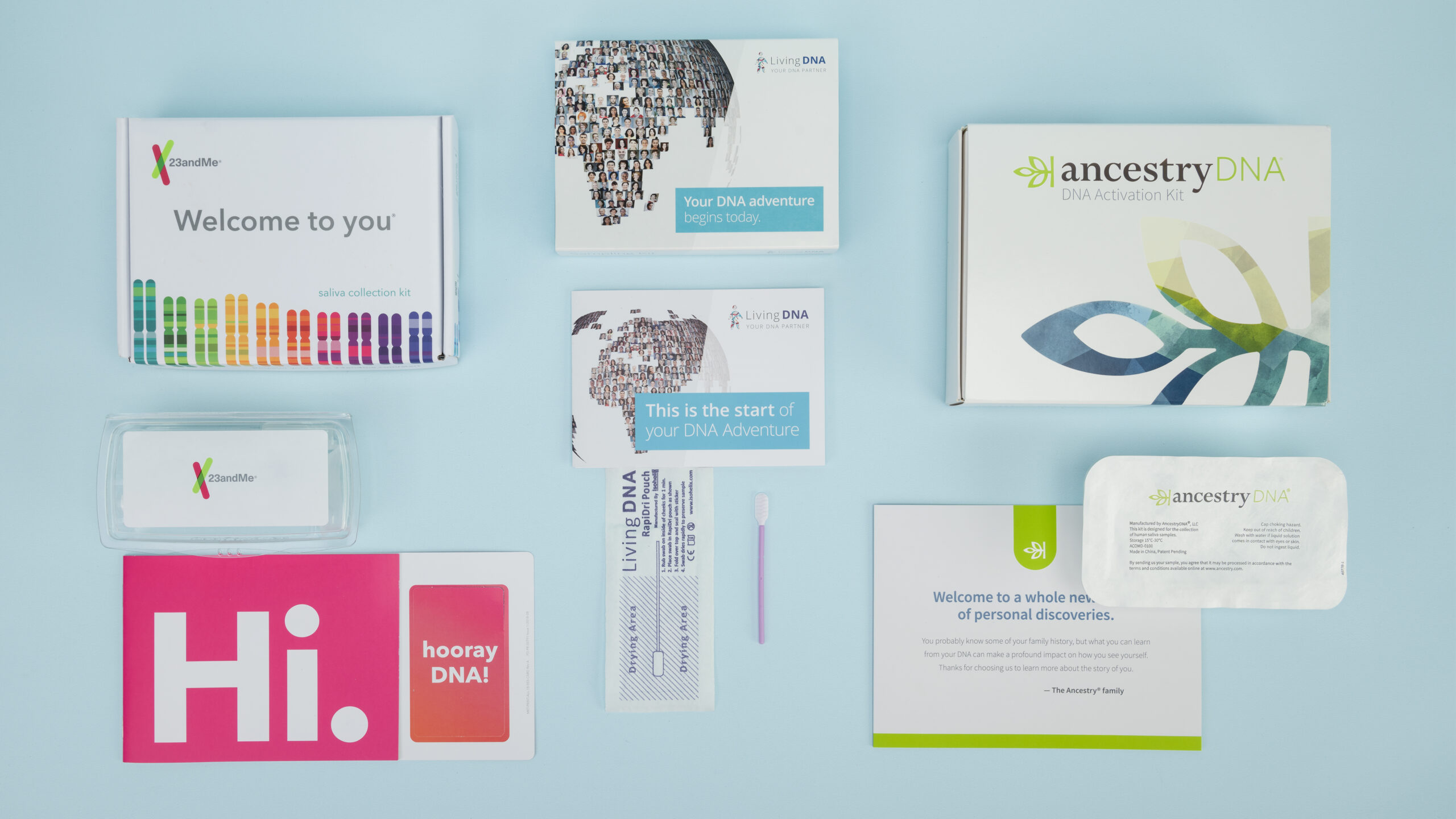

In This Article
In This Article
The most common genetic disorders in humans include:
These diseases can sometimes “skip” generations or lie dormant in that generation, but it may manifest in their offspring or their offspring’s offspring.
The human genome, or the complete set of DNA in each of our cells, is complex. While a DNA molecule contains instructions on a person’s growth and development, the human genome is subject to changes.1,2
The changes in the human genome can affect molecules that make up the DNA or even chromosomes. They can lead to genetic disorders that can be passed down.

There are more than 6,000 genetic disorders. Below are some of the most common genetic diseases.
Achondroplasia is a common genetic condition marked by slow bone growth due to protein malfunction. A person with this condition may have the following:
Achondroplasia is an autosomal dominant trait, meaning that just one copy of the mutated gene is enough to cause it to manifest.8
Achondroplasia is the most common mutation when it comes to stature. It occurs every one in 26,000-28,000 births.8

Achondroplasia is a disorder that can’t be cured, prevented, or treated. However, complications that may come with it can be addressed and managed.
Here are some treatments that may be administered or carried out for anyone suffering from complications from achodnroplasia:8
To manage common challenges faced by those with achondroplasia, the following are recommended:8
Cystic fibrosis is a genetic condition that causes your body to produce thick, sticky mucus. It also affects the secretion of other fluids like sweat and digestive juices.
If you have the cystic fibrosis gene, you may begin to have difficulty breathing as you grow older. The mucus buildup can block your airways.
Cystic fibrosis is an autosomal recessive disorder, which means two copies of the gene must be present for the disorder to manifest. This means that the parents, even if they carry the gene, may not show signs of it.9
Around 30,000 people in the United States have cystic fibrosis, with one in 30 people being carriers.10
Because of advancements in cystic fibrosis research, treating and managing cystic fibrosis is possible.11
To treat cystic fibrosis, you can opt for the following:11
Managing cystic fibrosis has also become easier. You can:
Down’s syndrome (or down syndrome) is a chromosomal defect that occurs when there’s an extra copy of chromosome 21. It can result in mental disability and delays in development.

A person with down syndrome usually possesses these facial and physical features:
Most cases of Down syndrome aren’t inherited. More often than not, Down syndrome is caused by a random error during the cell division process.12
About one in every 700 people have Down Syndrome.13
There is no cure for Down Syndrome, but you can manage the symptoms and make adjustments to suit your lifestyle, like:13
Duchenne Muscular Dystrophy (DMD) is a genetic condition marked by a continuous decline of the muscles. It is caused by mutations in the protein that keeps the muscles intact.
Symptoms of DMD may include:

DMD is X-linked recessive.14 This means that it’s only passed down via the X chromosome, and both parents need to be carriers.
Men are more likely to inherit DMD, with one in 3600 male infants inheriting the condition.14
There is no direct treatment for the condition itself, only managing and tackling the symptoms that come with it, like:14
Glucose-6 Phosphate Dehydrogenase (G6PD) is a genetic condition. The lack of the glucose-6 phosphate dehydrogenase enzyme in your body marks it.
This enzyme helps with the proper function of the red blood cells. An insufficient G6PD enzyme can shorten red blood cells’ lifespan and may lead to hemolytic anemia.
G6PD is X-linked recessive, meaning that men manifest the trait and women are more often carriers.15

While rare, G6PD mostly affects African American populations in America and those who live in more tropical areas. It’s said to affect around 400 million people worldwide.16
In most cases, G6PD only becomes a problem when you’re exposed to trigger foods or medicines, so avoidance is key. 15 You will also need to inform all your healthcare providers of what you’re avoiding so that the G6PD isn’t triggered.
Sickle Cell Anemia is a lifelong condition that can be inherited from both parents. It is a form of sickle cell disease. It affects the structure of your red blood cells (RBCs).
Normal RBCs are round and flexible, allowing them to easily move around the blood vessels. People with sickle cell anemia have deformed RBCs.
Some of their RBCs are shaped like sickles. These sickle cells are often sticky and rigid, blocking blood flow.
Sickle cell anemia is an autosomal recessive disorder, which means two copies of the gene must be present in offspring to manifest.17
There are fewer than 200,000 people in the United States with sickle cell anemia.17
Sickle cell anemia can be tricky to manage but not impossible. Here are some of the most widely available treatments and management options:18
Thalassemia is an inherited blood disorder. It affects your hemoglobin genes, affecting your body’s ability to generate healthy RBCs.
Symptoms may include:

Thalassemia is an autosomal recessive disorder, which means two copies of the gene must be present in offspring to manifest.19
Thalassemia is more common in Southeast Asia or in those of Southeast Asian descent. In the United States, up to 5% of people have the gene, with a little less than half being carriers only.20
Similar to sickle cell anemia, some of the more straightforward treatment and management options have to do with transfusions and, sometimes, even transplants. Here are some of them:21
Hemochromatosis is a disorder that causes excessive iron buildup in your body organs. It’s also called iron overload. It occurs when the body absorbs too much iron.
Excessive levels of iron are toxic to your body and may cause serious health problems, such as:
Hemochromatosis is an autosomal recessive disorder, which means two copies of the gene must be present in offspring to manifest.22
In the United States, about one in 300 white people have hemochromatosis, with a lower percentage observed in people of color.22

Managing hemochromatosis can be done by doing the following:22
Myotonic Dystrophy is a form of muscular dystrophy. It causes progressive muscle weakness and decline.
Symptoms of myotonic dystrophy include:
Myotonic Dystrophy is an autosomal dominant disorder, meaning just one copy of the mutated or abnormal allele is enough for you to be at risk.23
There are about ten cases of myotonic dystrophy in every 100,000 people.23 It’s more common in those with European ancestry.

There is no direct treatment for myotonic dystrophy, just ways you can manage your symptoms. You can opt for any of the following:23
Take note that those with myotonic dystrophy may not react well to general anesthesia. Remind any surgeon or healthcare provider of your myotonic dystrophy if you’re getting any surgery done.
Osteogenesis Imperfecta is a genetic disorder present at birth or congenital. It is also known as brittle bone disorder.
A person born with this disorder may have weak, easily fractured, or abnormally formed bones.
Osteogenesis Imperfecta is an autosomal dominant disorder, which means just one copy of the mutated or abnormal allele is enough for you to be at risk.24
Osteogenesis Imperfecta occurs in one in 20,000 people, pretty evenly across gender and race.24
There is currently no cure for Osteogenesis Imperfecta. You can try the following to manage the symptoms:24
Polycystic Kidney Disease (PKD) occurs when numerous cysts grow in your kidney. These clusters or cysts are non-cancerous but are filled with fluid.
They can cause kidney swelling. Over time, they can affect your kidney’s normal function.
There are two types of PKD: Dominant and Recessive. As the name implies, dominant polycystic kidney disease is an autosomal dominant disorder, meaning that just one copy of the mutated or abnormal allele is enough for you to be at risk.25 Recessive polycystic kidney disease is autosomal recessive, meaning two corrupted copies are necessary for it to manifest.
The dominant version is more prevalent, affecting one in 500 to 1,000 people. The recessive version only affects one in 20,000 to 40,000 people.

There is no cure for PKD, but ways to manage it:25

Know Your DNA Reviews

Don't miss out on the opportunity to learn more about yourself. Read our best DNA test page to find the best one for you.
Genetic disorders are conditions caused by gene mutations or changes in a person’s typical DNA sequence.3
DNA mutations may arise due to errors in DNA replication. Environmental factors, such as radiation exposure and cigarette smoking, can also cause gene changes.
DNA contains genetic material. It supplies the code for making proteins that allow the body to perform its functions.
When a change occurs in a part of the DNA, the process of protein coding is affected. As a result, some bodily functions are also affected.
The impact of DNA changes depends on where the mutations occurred.
Some mutations will have little to no effect. Others can completely alter the body’s cell biology, causing genetic disorders.
Scientists group genetic disorders into three main categories. The cause or location of the defect determines them.
Single-gene disorders are defects from a mutation in one particular gene. These disorders are often passed down in simple, straightforward ways and can be caused by just a single gene.4
Single-gene disorders are further classified into three types:
Chromosomal disorders are genetic diseases that result from changes in the chromosomes. They are also called chromosomal abnormalities.5
Chromosomes are thread-like structures within a cell’s nucleus or center. Each chromosome has a single DNA molecule tightly wrapped around proteins.
Their primary role is to ensure that the DNA is accurately replicated and distributed during cell division. We each have 23 pairs of chromosomes.
However, an affected person can have extra chromosomes in some chromosomal disorders. An example is Down’s syndrome (or Down syndrome), where a person has an excess copy of chromosome 21.

These are also known as multifactorial inheritance.
Complex disorders are caused by changes that occur in multiple genes. Often, these result from a complex interaction between lifestyle and other external factors.6
Scientists consider cancer to be a complex disorder.
A genetic diagnosis is determined through several approaches.
During a physical exam, a geneticist will conduct a thorough assessment. It may involve measuring distances between eyes, length of limbs, and head circumference.
This is because some genetic disorders are linked to distinct physical traits. Sometimes, facial features can suggest the presence of a genetic condition. Eye exams and neural exams are also performed.
Imaging studies may be used to get a picture of the structures found inside the body, such as:

A person’s medical history provides valuable insights into their health and well-being. Including past and current health issues, medications, and allergies are all essential.
You may share your test results with your doctor if you have undergone genetic testing before. It can give them further insights into your health history.
Genetic conditions are often passed down from generation to generation. Information regarding the health of family members is crucial. Family history can provide helpful insights in diagnosing conditions caused by mutations in the DNA.
Genetic counselors or doctors may ask about the health conditions of those closely related to you. These include your parents, siblings, children, and other close family members.
The information they obtain may reveal valuable clues. For example, they can learn the inheritance pattern of a genetic disorder that could potentially run in the family.

Lab tests, such as genetic testing, are used to diagnose genetic disorders. Several types of genetic tests can be used to diagnose a genetic disorder, including:7
Many genetic conditions can now be tested using a screening test and genetic testing. Some examples are newborn screenings and prenatal testing.
But in some conditions where no genetic test is available, it may help sequence the entire genome. Doing this can help locate the genetic variant responsible for the condition.

You can be diagnosed with a genetic disorder at any time within your lifetime. Some features of genetic conditions often appear very early or too late, so it’s essential to keep these tests in mind. The availability of testing may also affect diagnoses.
A diagnosis is very important, even if there’s currently no treatment available. This can help manage expectations and identify advocacy resources and proper support.
Know Your DNA Reviews

Looking for a DNA test that's accurate and can tell you about your health and heritage?

